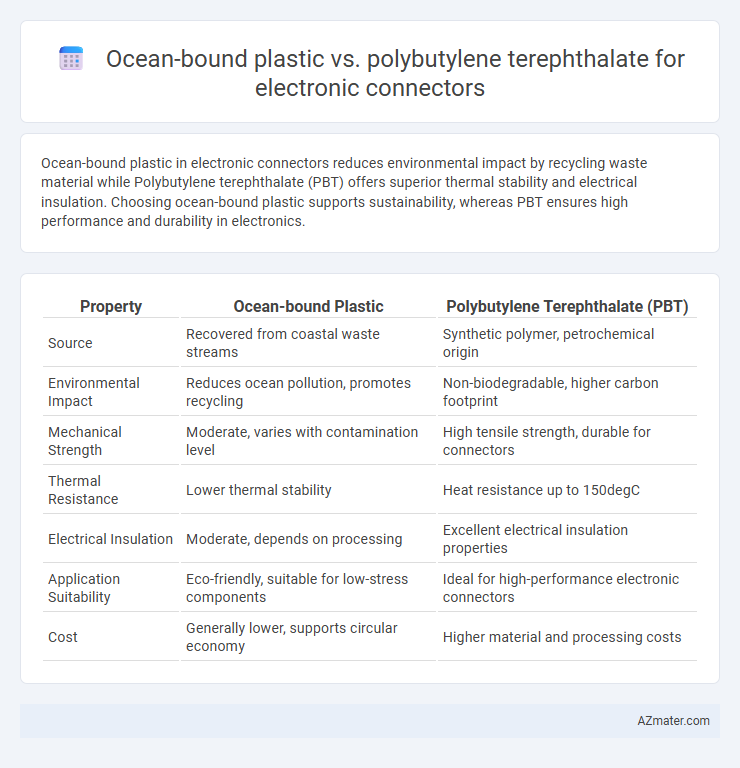Ocean-bound plastic in electronic connectors reduces environmental impact by recycling waste material while Polybutylene terephthalate (PBT) offers superior thermal stability and electrical insulation. Choosing ocean-bound plastic supports sustainability, whereas PBT ensures high performance and durability in electronics.
Table of Comparison
| Property | Ocean-bound Plastic | Polybutylene Terephthalate (PBT) |
|---|---|---|
| Source | Recovered from coastal waste streams | Synthetic polymer, petrochemical origin |
| Environmental Impact | Reduces ocean pollution, promotes recycling | Non-biodegradable, higher carbon footprint |
| Mechanical Strength | Moderate, varies with contamination level | High tensile strength, durable for connectors |
| Thermal Resistance | Lower thermal stability | Heat resistance up to 150degC |
| Electrical Insulation | Moderate, depends on processing | Excellent electrical insulation properties |
| Application Suitability | Eco-friendly, suitable for low-stress components | Ideal for high-performance electronic connectors |
| Cost | Generally lower, supports circular economy | Higher material and processing costs |
Understanding Ocean-Bound Plastic: Definition and Source
Ocean-bound plastic refers to plastic waste collected within 50 kilometers of coastlines that would otherwise enter marine environments, posing significant ecological risks. This plastic is often sourced from coastal communities with inadequate waste management systems, including discarded fishing gear and consumer packaging. Utilizing ocean-bound plastic for electronic connectors promotes sustainable manufacturing by reducing marine pollution and repurposing materials that contribute to environmental degradation.
Introduction to Polybutylene Terephthalate (PBT) in Electronics
Polybutylene terephthalate (PBT) is a high-performance thermoplastic widely used in electronic connectors due to its excellent electrical insulation, mechanical strength, and resistance to heat and chemicals. Unlike ocean-bound plastics, which are recycled waste materials sourced near coastlines and primarily used for sustainability-driven applications, PBT offers consistent material properties essential for the reliability and durability of electronic components. Its low moisture absorption and dimensional stability under thermal stress make PBT a preferred choice in harsh electronic environments where precision and performance are critical.
Key Physical Properties: Ocean-Bound Plastic vs PBT
Ocean-bound plastic exhibits moderate tensile strength and flexibility but has lower thermal stability compared to polybutylene terephthalate (PBT), which offers high mechanical strength, excellent dimensional stability, and superior heat resistance up to 150degC. PBT's dielectric properties and low moisture absorption make it ideal for electronic connectors, whereas ocean-bound plastic's performance varies due to mixed polymer content and potential contamination. The consistent molecular structure of PBT ensures reliable electrical insulation and durability, outperforming ocean-bound plastic in critical physical properties for electronic applications.
Environmental Impact: Life Cycle and Sustainability
Ocean-bound plastic used in electronic connectors reduces marine pollution by diverting waste from ecosystems, significantly lowering the environmental footprint associated with raw material extraction and plastic waste management. Polybutylene terephthalate (PBT), a durable and recyclable engineering thermoplastic, offers enhanced longevity and resistance to harsh conditions, yet its production involves petrochemical resources contributing to carbon emissions. Comparing life cycles, ocean-bound plastic emphasizes waste reduction and circularity, while PBT focuses on performance and recyclability, both contributing uniquely to sustainability in electronic connector manufacturing.
Performance in Electronic Connectors: Mechanical Strength and Durability
Ocean-bound plastic composites exhibit moderate mechanical strength and durability but often fall short compared to Polybutylene terephthalate (PBT), which demonstrates superior tensile strength, impact resistance, and dimensional stability in electronic connectors. PBT's resistance to heat, chemicals, and wear ensures reliable performance under demanding environmental conditions, essential for maintaining connector integrity and lifespan. While ocean-bound plastics offer sustainable alternatives, PBT remains the preferred choice for critical electronic connector applications requiring high mechanical robustness and long-term durability.
Processability and Manufacturing Efficiency
Ocean-bound plastic offers sustainable material sourcing but presents challenges in consistency and purity, impacting molding precision for electronic connectors. Polybutylene terephthalate (PBT) boasts superior processability with excellent dimensional stability, chemical resistance, and fast cycle times during injection molding, enhancing manufacturing efficiency. High melt strength and thermal properties of PBT contribute to reliable connector production, reducing defects and downstream assembly issues compared to ocean-bound plastic variants.
Electrical Properties and Safety Considerations
Ocean-bound plastic used in electronic connectors offers environmental benefits but generally exhibits lower electrical insulation and thermal stability compared to Polybutylene terephthalate (PBT), which is engineered for high dielectric strength and flame resistance essential for reliable electronic performance. PBT's superior electrical properties, including low dielectric constant and high volume resistivity, enhance signal integrity and reduce electrical noise, while its inherent flame retardancy ensures compliance with stringent safety standards in electronics. Safety considerations favor PBT in high-performance connectors due to its consistent behavior under electrical stress and thermal conditions, whereas ocean-bound plastics require rigorous treatment and testing to meet equivalent safety certifications.
Cost Comparison and Market Availability
Ocean-bound plastic offers a cost-effective and sustainable alternative to polybutylene terephthalate (PBT) in electronic connectors, with raw material expenses often 20-30% lower due to recycled content. Market availability of ocean-bound plastic is increasing steadily, driven by rising environmental regulations and consumer demand, yet PBT remains more widely available with established supply chains and consistent quality. Despite higher upfront costs, PBT benefits from superior mechanical properties and thermal stability, maintaining dominance in high-performance connector applications.
Application Suitability: Case Studies and Industry Adoption
Ocean-bound plastic offers an eco-friendly alternative for electronic connectors, demonstrating successful application in consumer electronics and automotive industries where sustainability is prioritized. Polybutylene terephthalate (PBT) remains favored for high-performance connectors due to its superior thermal stability, mechanical strength, and chemical resistance, which are critical in industrial and telecom sectors. Case studies reveal that blending ocean-bound plastic with PBT enhances environmental impact without compromising durability, accelerating industry adoption towards greener manufacturing practices.
Future Trends: Innovations and Material Advancements
Ocean-bound plastic is gaining traction as a sustainable alternative for electronic connectors, offering environmental benefits by preventing marine pollution while maintaining essential mechanical properties. Polybutylene terephthalate (PBT) continues to evolve with enhanced flame retardancy, thermal stability, and mechanical strength, supporting higher-performance electronic applications. Future trends point toward hybrid materials that combine ocean-bound plastic's eco-friendly attributes with PBT's durability, driving innovations in recyclable, high-reliability connectors for emerging technologies.

Infographic: Ocean-bound plastic vs Polybutylene terephthalate for Electronic connector
 azmater.com
azmater.com